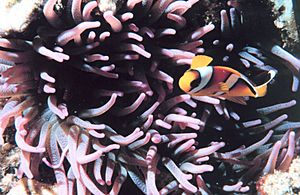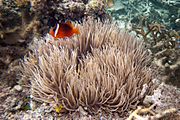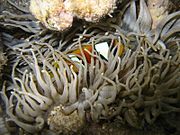Sebae anemone facts for kids
Quick facts for kids Sebae anemone |
|
|---|---|
 |
|
| A Red Sea clownfish living in a sebae anemone | |
| Scientific classification |
The sebae anemone (Heteractis crispa) is a type of sea anemone found in the warm waters of the Indo-Pacific region. People also call it the leathery sea anemone, long tentacle anemone, or purple tip anemone. It belongs to a group of anemones called Stichodactylidae.
Contents
What is a Sebae Anemone?
The sebae anemone has a wide, flat top part called an oral disc. This disc can grow to be about 20 to 50 centimeters (8 to 20 inches) wide. It has many long tentacles, usually 10 to 15 centimeters (4 to 6 inches) long. The tips of these tentacles are often purple or blue.
The main body of the anemone, which you see when it closes up, is gray. It has sticky, whitish bumps on it. Like other Hexacorallia animals, the sebae anemone usually has tentacles in groups of six, arranged in circles. These tentacles can be light beige to purple in color.
Where Sebae Anemones Live
You can find the sebae anemone in the tropical and subtropical parts of the Indo-Pacific. This area stretches from the eastern coasts of Africa, including the Red Sea, all the way to Polynesia. It also goes from southern Japan down to Australia and New-Caledonia.
These sea anemones like to attach themselves to hard surfaces that are lightly covered with sand. They can also cling to branching corals. They live in waters from the surface down to about 40 meters (130 feet) deep.
Life Cycle and How They Eat
The sebae anemone gets its food in two main ways.
- First, it has tiny helpers called zooxanthellae living inside its body. These helpers are like tiny plants that make food using sunlight, a process called photosynthesis.
- Second, the anemone uses its tentacles to catch food. It can grab small creatures like tiny invertebrates, baby fish, or young fish that swim by. Its tentacles help it to hold onto and eat its prey.
Sebae anemones can reproduce in two ways:
- Sexual reproduction: They release male and female cells, called gametes, into the water at the same time. These cells then combine to create new anemones.
- Asexual reproduction: They can also reproduce by simply dividing themselves. This is called scissiparity. The anemone splits into two separate individuals, either from its foot or its mouth.
Friends of the Sebae Anemone
The sebae anemone is a popular home for many different types of anemonefish, also known as clownfish. It hosts about 15 different species! This means it's a very welcoming home for many kinds of clownfish.
One special clownfish, the wide-band anemonefish (Amphiprion latezonatus), only lives with the sebae anemone. In some places, like the Red Sea, the sebae anemone acts like a "nursery" for young clownfish. Adult clownfish usually move to other types of anemones when they grow up.
Here are some of the anemonefish that live with the sebae anemone:
- Amphiprion akindynos (Barrier Reef anemonefish)
- A. barberi (Barber's anemonefish)
- A. bicinctus (two-band anemonefish)
- A. chrysopterus (orange-fin anemonefish)
- A. clarkii (Clark's anemonefish)
- A. ephippium (red saddleback anemonefish)
- A. latezonatus (wide-band anemonefish)
- A. leucokranos (white-bonnet anemonefish)
- A. melanopus (red and black anemonefish)
- A. omanensis (Oman anemonefish)
- A. percula (clown anemonefish)
- A. perideraion (pink skunk anemonefish)
- A. polymnus (saddleback anemonefish)
- A. sandaracinos (orange anemonefish)
- A. thiellei
- A. tricinctus (three-band anemonefish)
Young fish of another species, Dascyllus trimaculatus, also sometimes live with H. crispa.
Gallery
Anemonefish in H. crispa
-
A. latezonatus (wide-band anemonefish)
-
A. sandaracinos (orange skunk anemonefish)
See also
 In Spanish: Anémona cuero para niños
In Spanish: Anémona cuero para niños







